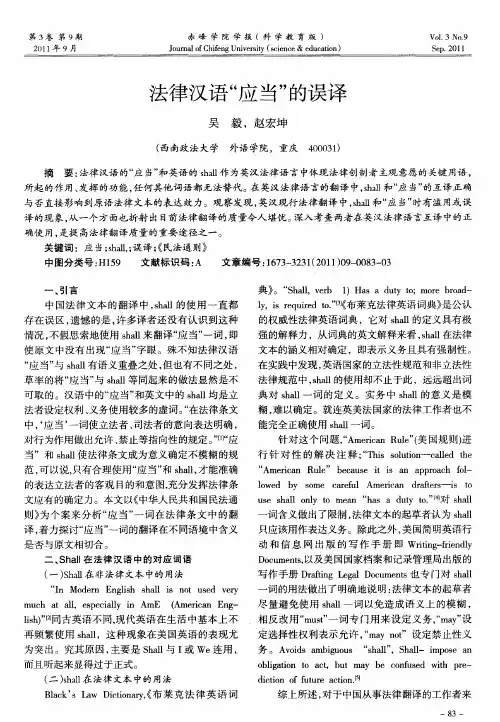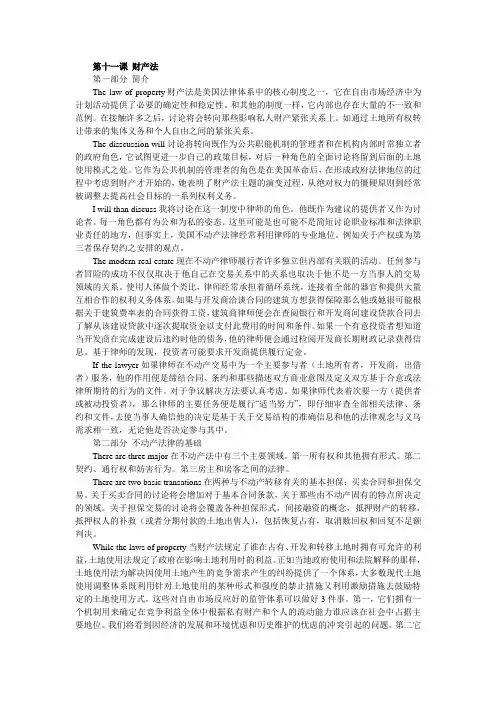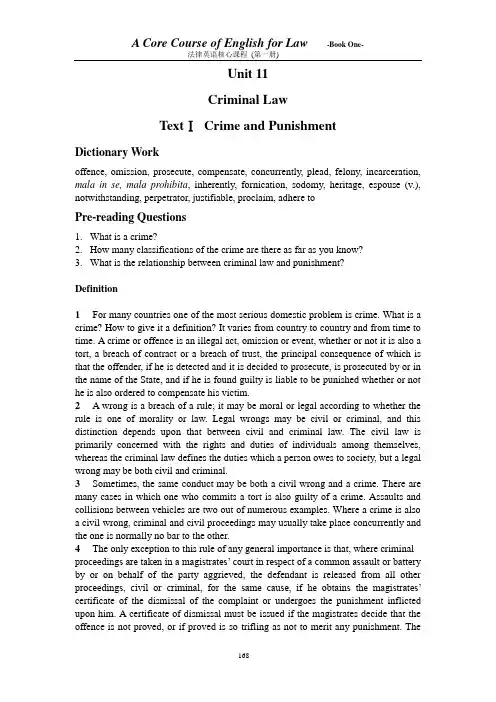法律文本翻译第十一章 法律文本正、误译例析[精]
- 格式:ppt
- 大小:1.05 MB
- 文档页数:39
![法律解释学第十一章 目的性扩张与目的性限缩[精]](https://uimg.taocdn.com/ef34adad8bd63186bdebbc5f.webp)


本科法律专业毕业论文范文随着我国法律人才市场的逐渐饱和,法律人才的需求相对越来越细化,面对不同层次的需求,设置法律专业的高职高专院校应该确定具有自己办学特色的培养目标,以契合社会的需求,最终实现教学的意义。
下面是店铺为大家整理的本科法律专业毕业论文,供大家参考。
本科法律专业毕业论文范文一:法律英语误译分析一、法律术语的特征分析(一)经常使用常用词汇的不常用的含义由于法律术语的专业性很强,在我们翻译法律文件时,也许见到平常经常看到的一些词汇,然而在法律文件中,它却有自己独特的含义。
例如:action是我们常见的一个词汇,它的意思是行动,然而在法律上它指的是alawsuit(eithercivilorcriminal);alien这个常用词汇在法律上的含义是totransferpropertytoanother;bill的法律含义是adraftlaw;就连我们最常见的color一词在法律中的含义也发生了改变,它的意思是apparentlegalright(e.g.undercoloroflaw),象这样的例子还有很多很多。
(二)经常使用古英语和中世纪英语词汇,甚至还有很多外来语词汇例如:Aforementioned,Alack,Hereinafter,Howbeit,Nowise,Verily,Withal 等等这些词汇均来源于古英语和中世纪英语,还有例如abinitio(意思是fromthebeginning),adhoc(意思是forthispurpose),alibi(意思是elsewhere),caveat(意思是awarning)等等这些词汇都是拉丁语单词和短语,但是这些词汇却出现在英文法律文件之中。
还有例如:cypres(意思是asnearaspossible),delict(意思是wrong,offense),demur(意思是nottoagree)等等,这些词汇均来自法律法语的词汇。



![法律文本翻译第十二章 常用法律文本翻译示例[精]](https://uimg.taocdn.com/c24c7469be23482fb4da4cc2.webp)


第十一课财产法第一部分简介The law of property财产法是美国法律体系中的核心制度之一,它在自由市场经济中为计划活动提供了必要的确定性和稳定性。
和其他的制度一样,它内部也存在大量的不一致和范例。
在接触许多之后,讨论将会转向那些影响私人财产紧张关系上。
如通过土地所有权转让带来的集体义务和个人自由之间的紧张关系。
The disscussion will讨论将转向既作为公共职能机制的管理者和在机构内部时常独立者的政府角色,它试图更进一步自己的政策目标,对后一种角色的全面讨论将留到后面的土地使用模式之处。
它作为公共机制的管理者的角色是在美国革命后,在形成政府法律地位的过程中考虑到财产才开始的,她表明了财产法主题的演变过程,从绝对权力的僵硬原则到经常被调整去提高社会目标的一系列权利义务。
I will than discuss我将讨论在这一制度中律师的角色。
他既作为建议的提供者又作为讨论者。
每一角色都有为公和为私的姿态。
这里可能是也可能不是简短讨论职业标准和法律职业责任的地方,但事实上,美国不动产法律经常利用律师的专业地位。
例如关于产权或为第三者保存契约之安排的观点。
The modern real estate现在不动产律师履行者许多独立但内部有关联的活动。
任何参与者冒险的成功不仅仅取决于他自己在交易关系中的关系也取决于他不是一方当事人的交易领域的关系。
使用人体做个类比,律师经常承担着循环系统,连接着全部的器官和提供大量互相合作的权利义务体系。
如果与开发商洽谈合同的建筑方想获得保障那么他或她很可能根据关于建筑费率表的合同获得工资,建筑商律师便会在查阅银行和开发商间建设贷款合同去了解从该建设贷款中逐次提取资金以支付此费用的时间和条件。
如果一个有意投资者想知道当开发商在完成建设后违约时他的债务,他的律师便会通过检阅开发商长期财政记录获得信息。
基于律师的发现,投资者可能要求开发商提供履行定金。
If the lawyer如果律师在不动产交易中为一个主要参与者(土地所有者,开发商,出借者)服务,他的作用便是缔结合同、条约和那些描述双方商业意图及定义双方基于合意或法律所期待的行为的文件。

Unit 11Criminal LawTextⅠCrime and PunishmentDictionary Workoffence, omission, prosecute, compensate, concurrently, plead, felony, incarceration, mala in se, mala prohibita, inherently, fornication, sodomy, heritage, espouse (v.), notwithstanding, perpetrator, justifiable, proclaim, adhere toPre-reading Questions1.What is a crime?2.How many classifications of the crime are there as far as you know?3.What is the relationship between criminal law and punishment?Definition1For many countries one of the most serious domestic problem is crime. What is a crime? How to give it a definition?It varies from country to country and from time to time. A crime or offence is an illegal act, omission or event, whether or not it is also a tort, a breach of contract or a breach of trust, the principal consequence of which is that the offender, if he is detected and it is decided to prosecute, is prosecuted by or in the name of the State, and if he is found guilty is liable to be punished whether or not he is also ordered to compensate his victim.2 A wrong is a breach of a rule; it may be moral or legal according to whether the rule is one of morality or law. Legal wrongs may be civil or criminal, and this distinction depends upon that between civil and criminal law. The civil law is primarily concerned with the rights and duties of individuals among themselves, whereas the criminal law defines the duties which a person owes to society, but a legal wrong may be both civil and criminal.3Sometimes, the same conduct may be both a civil wrong and a crime. There are many cases in which one who commits a tort is also guilty of a crime. Assaults and collisions between vehicles are two out of numerous examples. Where a crime is also a civil wrong, criminal and civil proceedings may usually take place concurrently and the one is normally no bar to the other.4The only exception to this rule of any general importance is that, where criminal proceedings are taken in a magistrates’ court in respect of a common assault or battery by or on behalf of the party aggrieved, the defendant is released from all other proceedings, civil or criminal, for the same cause, if he obtains the magistrates’ certificate of the dismissal of the complaint or undergoes the punishment inflicted upon him. A certificate of dismissal must be issued if the magistrates decide that the offence is not proved, or if proved is so trifling as not to merit any punishment. Thepower to dismiss a case even though the offence is proved, which is peculiar to the above off ences, depends on there having been a hearing “on the merits” and this will not have occurred if the accused pleaded guilty.Criminal Law Classifications5Criminal law classifies crimes according to various criteria, including (1) the nature and degree of p enalty attached, (2) the nature and degree of “evil” involved, and (3) the kind of social harm.Felony, Misdemeanor, and Violation6 The past influences present criminal law. The great legal historian Frederic William Maitland maintained that the reasons for old classifications may have long since died, but their ghost ruel us from the grave. He meant that even when classifications have outlived their usefulness, they influence present practice. The classification that divides crimes into felonies and misdemeanors represents one example of the past ruling us from the grave. Historically, felonies were crimes punishable by death. Present law divides felonies into capital felonies and ordinary felonies. Therefore, the category includes both serial killers such as Ted Bundy at one extreme and individuals who steal £500 at the other. The breadth of its scope makes the classification largely meaningless in any sociological sense. It serves mainly as an administrative device to determine who gets the death penalty, life imprisonment, or incarceration in a state prison.7 Misdemeanors include crimes punishable either by fines or up to one year in jail. Common misdemeanors include simple assaults and battery, prostitution, and disorderly conduct. Most jurisdictions divide misdemeanors into gross misdemeanors.A third category of crime is violation. Traffic offenses fall into this group..Mala in se and Mala Prohibita8Another legal classification sorts crimes according to their perceived “evil.” This old arrangement overlaps the felony, misdemeanor, and violation categories and defines some crimes as inherently bad (the Latin mala in se). Crimes such as murder and rape fall into this category. Other behavior constitutes a crime only because the law says so (the Latin mala prohibita). Parking in a “no parking” zone is malum prohibitum.9This classification reflects American criminal law’s roots in the religious and moral codes of England and colonial America. Although frequently viewed as a preoccupation of the New England Puritans, the Anglicans of Virginia, Pennsylvania Quakers, and Maryland Catholics also infused criminal law with a moral component. The major felonies and “morals” offenses, fornication, prostitution, sodomy, gambling, and public drunkenness, descend from this religious and moral heritage.10In practice, no bright line separates mala in se and mala prohibita offenses. In fact, research demonstrates that despite legal theories espousing the distinction, and notwithstanding talk of an ethical core in the criminal law, perpetrators consider manycrimes formally classified mala in se “justifiable”-that is, a means to put right a keenly felt wrong. They believe their conduct may have been “technically” a crime, but definitely not evil. Despite these findings, legal theorists cling to the distinction.Crime, Law and Punishment11 “N o crime without law and no punishment without law” proclaim two ancient maxims governing formal criminal justice. Formally, modern criminal law adheres to these maxims in the firmly fixed principle of legality that underlies the substantive criminal law, that is, the law that defines what constitutes a crime. The principle of legality also applies to the law of criminal procedure, the law that prescribes how the government enforces the substantive criminal law, in such constitutional commands as “no deprivation of life, liberty, or property without due process of law” and the guarantee of equal protection of the laws.12In practice, much reprehensible conduct, some of which causes considerable harm, occurs in every society. Neither all of that conduct nor all of that harm constitutes a crime. The law determines the distinction between unethical, immoral injury that justifies non-criminal legal action and criminal conduct and harm. To qualify as crimes, conduct or harm must satisfy five requirements; (1) A specific law prohibits the conduct and/or harm. (2) The law prescribes a penalty for the prohibited conduct and/or harm. (3) The particular law conforms to the general purposes and principles of criminal law. (4) The government must adhere to the rules of procedure in administering and enforcing the criminal law. (5) The punishment prescribed and actually administered accords with the Constitution’s prohibition against cruel an d unusual punishment.(1089words) Cross Jones &Card, Introduction to Criminal Law, 11th edition, Butterworth & Co (Publishers) Ltd.; Joel Samaha, Criminal Justice, 2nd edition, West Publishing CompanyNotes_________________________1.capital felony: Crime punishable by death or life imprisonment.可判死刑或终生监禁的重罪。

法律文书汉译英一. 法律翻译的基本原则对于法律翻译,译者不宜片面追求形式上的对等,要求译文的词类、语序和句子结构与原文基本保持一致。
法律文件的翻译质量必须用译文读者对译文的反映程度来衡量。
法律文体的翻译应该遵循奈达提出的“功能对等”翻译原则,即“译文读者对译文的反应等值于原文读者对原文的反应。
⏹公正⏹准确⏹合适⏹简洁,精练⏹体现译入语的语域特征1.公正性(impartiality)法律专业人员要遵守的最为基本的原则。
法律翻译是法律行业工作的一部分,因此公正性也应是法律翻译的最为基本的原则。
就法庭翻译来看,译员是在讲话人双方之间传达信息,是双方共同的沟通渠道。
表面看来,公正性似乎不成问题,但在很多情况下,译员被看成发言人的“语言和心理的避难所”,就是说发言人力求从译员获取支持,或者寻取解脱,译员也难受到一定的影响。
另一方面,译员也有可能主动地扮演保护者的角色,偏向一方。
这时他们不仅仅是在为讲话人传达信息,而是在自己讲话。
不论译员或当事人有多充分的理由支持译员超越权限,从全面的职业要求看,译员仍然从原则上坚持公正性,作到不偏不倚。
法庭口译如此,书面翻译亦如此。
2.准确性准确性被看作法律语言的灵魂,而语言被认为是法律的支柱、法律的载体。
法律翻译处理法律语言材料,也要固守准确性的原则。
仅涉及一种语言时,准确性原则要求语言使用者对法律概念、原理、规范以及所涉及的社会行为进行严格的审视和表达。
由于法律法规的概括性和一定程度的灵活性,准确性的实现往往是一个人们孜孜以求但难以达到的目标。
在法律活动涉及两种语言时,除了仅涉及单语时造成的困难外,又有不同法律文化的影响。
更多因素的介入以及语言表达的差异,使准确性及准确性的判断标准更加复杂,因此也对译员提出更严格的要求。
3.合适性反映翻译的度,包括对讲话人双方的了解程度,对语体运用的恰切程度,对讲话(或文本)原意传达的充分程度,也包括上文所提到的译员权限的控制程度等。